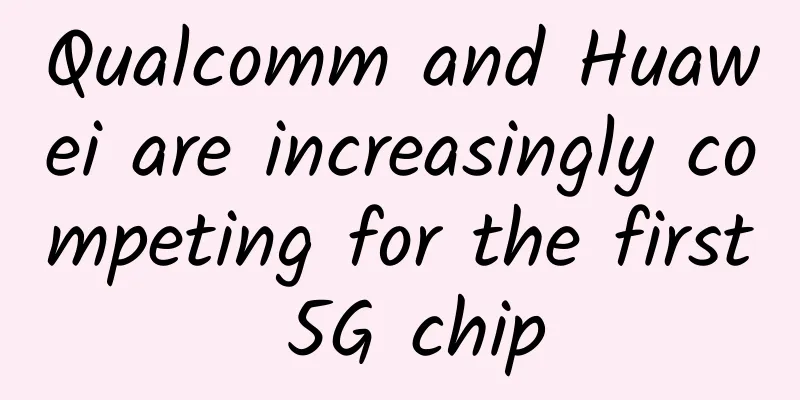Qualcomm and Huawei are increasingly competing for the first 5G chip

|
Qualcomm, which was overshadowed by Huawei's "first artificial intelligence processor" last year, decided not to make the same mistake again this time. On the evening of August 22, Qualcomm officially announced that it will launch a system-on-chip platform with a 7nm process technology, which can be paired with the Snapdragon X50 5G modem. In its official press release, Qualcomm described it as "the first flagship mobile platform that supports 5G and is targeted at top smartphones and mobile devices."
Image from Pixabay Although the official statement is vague, the industry knows that this flagship mobile platform refers to the Snapdragon 855. Qualcomm said that the new mobile platform has been sampled by many OEM manufacturers to help them release new smartphones that support 5G networks in the first half of 2019. Qualcomm's two main businesses are technology patent licensing and semiconductor chips, while Huawei is relatively diversified, with consumer electronics products such as mobile phones and tablets, as well as communications equipment and cloud services. The two companies are not in direct competition in their main businesses, and they are even bound to cooperate, but in the past two years, there has been more tension between them. Qualcomm suffered a "secret loss" No one wants to make the same "mistake" a second time. In September 2017, Huawei released its annual flagship chip Kirin 970 in Berlin, Germany. This SoC uses TSMC's 10nm process and has a built-in independent NPU (neural network unit). Intentionally or unintentionally, Kirin 970 was promoted in China as "the world's first artificial intelligence mobile processor." "It's boiling!", "The smartphone industry is getting excited!"... During that period, there were endless self-media articles using such adjectives. At that time, the popularity of Kirin 970 was only slightly inferior to that of Apple's new iPhone launched in the same month. This was originally a happy thing, but Huawei's public relations team was a little troubled at the time: the little pinks spontaneously praised Huawei too much. On the other hand, Huawei's early promotion of the "artificial intelligence processor" caught Qualcomm off guard. Almost at the same time as the release of Kirin 970, Qualcomm held a small media communication meeting. The main purpose was to spread the word that it had started its artificial intelligence project as early as 2007, and that its first-generation artificial intelligence platform was already installed on the Snapdragon 820 two years ago. Of course, Qualcomm’s communication was quickly drowned out by the massive amount of articles promoting Kirin 970. On the eve of the release of Qualcomm Snapdragon 845 in December of the same year, the product manager of Qualcomm's flagship chip 8 series commented on Huawei's Kirin 970 and told media such as Phoenix Technology: "Huawei has made some noise in the chip field, but we are the best." In the subsequent product promotion of Snapdragon 845, Qualcomm also made the improvement of artificial intelligence one of the key points of its publicity, emphasizing that this third-generation AI mobile platform not only has CPU, GPU, and DSP that support AI algorithms, but also has a computing power that is three times higher than the previous generation Snapdragon 835. In fact, the tit-for-tat between Huawei and Qualcomm is not just a publicity grab. In addition to the chip business, the technology patent licensing business has always been Qualcomm's largest source of profit. Apple, Samsung and other mobile phone giants have paid Qualcomm a considerable amount of patent fees, including Huawei. Qualcomm is a company that started out with technology research and development. Every mobile phone has Qualcomm's inventions. According to Qualcomm's patent licensing model, whether or not you use its Snapdragon chips, you need to pay it a technology transfer fee. In other words, Huawei currently uses a large number of its own Kirin chips, but it still has to pay Qualcomm a penny less in patent fees. Apple sued Qualcomm last year over patent fees, arguing that the patent licensing fees Qualcomm charged for every iPhone were completely unreasonable, and the lawsuit has not been settled until now. Huawei and Samsung have also been quite dissatisfied with this, which is no secret in the industry. In November last year, Qualcomm lowered the licensing fee rates for standard essential patents, including 5G. After the adjustment, the actual licensing fee rate for single-mode 5G mobile phones is 2.275% of the sales price; the actual licensing fee rate for multi-mode (3G/4G/5G) mobile phones is 3.25% of the sales price. In this adjustment, Qualcomm set a cap price of US$400 (about RMB 2,670) for the net selling price of each mobile phone, which means that a smartphone with a net selling price of US$500 is also calculated at US$400. But even if it is reduced, for mobile phone manufacturers like Huawei, which shipped 153 million units worldwide last year and aims to ship 200 million units this year, this patent fee is still a considerable expense. In the upcoming 5G era, Qualcomm wants to maintain its market position in the 3G and 4G eras, while Huawei, Samsung and others want to reverse their passive position. The friction between the two sides came to the fore during the Mobile World Congress in Barcelona in February this year. The smell of gunpowder is getting stronger On February 25, local time, Huawei held a new product launch conference. The "One More Thing" at the conference was a 5G chip - Balong 5G01. Huawei said in an official press release that this is "the first commercial 5G chip based on the 3GPP standard." At the 5G media communication meeting on the second day, Qualcomm Senior Director of Marketing Peter Carson retorted at the beginning: "The industry's attention to 5G has been increasing recently, and we have also noticed that some friendly competitors hope to 'rewrite history'." The "friendly competitors" Peter Carson mentioned are Huawei. He said that Qualcomm had already released the world's first 5G modem, the Snapdragon X50 5G modem, at last year's MWC; in October last year, it announced the Snapdragon X50 5G modem chipset in Hong Kong, achieving the world's first 5G data connection (data call). Perhaps a little unsatisfied, Peter Carson then added: "We have also seen that our competitors have launched their 5G chipsets, which are still relatively large and not suitable for the needs of mobile terminals. Our goal has always been that 5G chipsets must meet the needs of mobile terminals for size, performance and connection speed." As if sensing the delicate relationship between the two companies, Huawei's rotating chairman Xu Zhijun and founder Ren Zhengfei have stated since the beginning of this year that Huawei and Qualcomm are still good partners. First, at Huawei's Global Analyst Conference in April this year, Xu Zhijun said that Huawei does not position chips as an independent business and will not generate external revenue based on chips. He said at the time that Huawei has always clearly adopted a multi-chip supply strategy in terms of smartphones, and Huawei has no idea or plan to sell Kirin chips to the outside world. "We can't rely on just one thing. If we rely on just one thing, what will happen to our smartphones if Kirin chips fall behind one day?" Xu Zhijun said. The implication is that although Huawei's mid-to-high-end mobile phones and tablets currently use its own Kirin chips, there will be no commercial competition with Qualcomm in the chip business. As the founder of Huawei, Ren Zhengfei's statement was more direct. On July 3 this year, Ren Zhengfei gave a speech at the Fellow and some European Research Institutes Symposium with the theme of "Working hard to govern and revitalize in ten years". In his speech, he said that Huawei will buy 50 million chips from Qualcomm this year. "We will never go to the opposite side, we are all creating for mankind. We will always be friends with Intel, Broadcom, Apple, Samsung, Microsoft, Google, Qualcomm... " Ren Zhengfei said. At this point, Qualcomm seems to be relieved: Huawei will not be a competitor. But between eternal friends, occasional teasing is inevitable in business. At the semi-annual performance communication meeting of Huawei's consumer business earlier this month, Huawei's consumer business CEO Yu Chengdong had already said that it was difficult to evaluate the Snapdragon 855 before it was released, but Huawei's Kirin 980 would "far surpass Qualcomm's Snapdragon 845." He said at the time: "I'll brag about it first, and you'll see when the time comes." For mobile phone processors, smaller chip process means stronger performance. This time, Huawei claims that Kirin 980 will be the world's first mobile platform using 7nm process. But this time, Qualcomm doesn't want Huawei to steal the limelight of the first 7nm process and, most importantly, the world's first 5G mobile processor. So, one week before Huawei's Kirin 980 launch in Germany and more than three months ahead of the official launch, Qualcomm announced that its next-generation flagship SoC will also adopt the new generation 7nm process and support 5G network connection. At the same time, Qualcomm also announced that the industry has already provided samples to mobile phone manufacturers, and consumers will see 5G mobile phones equipped with Snapdragon 855 in the first half of next year. Competition among 5G chip manufacturers In order to gain the first-mover advantage in the next-generation mobile communication technology 5G network, not only Qualcomm, but also Samsung, MediaTek and other manufacturers are accelerating their layout. On August 15, Samsung launched its first 5G baseband chip, Exynos Modem 5100, which uses a 10nm process. Samsung said that this is the world's first 5G baseband chip that fully complies with the 3GPP R155G international standard and has successfully passed the wireless call test between the 5G prototype terminal and the 5G base station. Samsung said that this chip will be officially launched at the end of 2018, and devices equipped with this chip will be shipped in the first quarter of 2019. This is another major move by Samsung after it announced the 3.5GHz 5GNR base station in July this year. The intention behind it is obvious - it is aimed at 5G. At the Taipei International Computer Show in June this year, another chip company, MediaTek, also released its first 5G baseband chip, the M70, which is also built on TSMC's 7nm process. It will support 5G NR (New Radio) and comply with the latest standard specifications of 3GPP Release 15, but it will not be officially commercialized until early 2019. Compared with Qualcomm Snapdragon X50's 5G progress, MediaTek is slower. Qualcomm has previously signed large-scale purchase intention agreements with mobile phone manufacturers such as Xiaomi, OPPO, and vivo. For MediaTek, whose chip market share has been continuously squeezed in the past two years, it may still be suppressed by Qualcomm in 5G chips in the future. According to the timetable given by China Mobile, China Unicom and China Telecom, the 5G network will start trial commercial use in the first half of next year and will be officially put into commercial use in 2020. Currently, the three major operators have also started 5G network pilots in many popular cities across the country. According to market research firm Digitimes Research, 5G terminal devices including smartphones, CPE and WiFi devices will not see large-scale shipments until 2021 after they go on sale in the market in 2019. As chip giants continue to accelerate their pace in 5G commercialization, the timetable for the release of 5G smartphones has become clearer, and the competition for the release of the first batch of 5G smartphones has become more intense. For example, Samsung said it would launch 5G phones in March 2019, Huawei said it would launch 5G phones in June 2019, and OPPO and vivo also said they would become the first manufacturers to launch 5G phones in 2019. While the giants are competing with each other, the era of 5G mobile phones is here. |
<<: QQ Pets will be shut down next month. It was never WeChat that defeated Tencent QQ.
>>: Android Butterknife (Butter Knife) Usage Summary
Recommend
Switching to the "Google Model": Alibaba's new path for home Internet
The concept of home Internet continues to be popu...
Zhou Zhonghe, academician of the Chinese Academy of Sciences: Humanistic spirit is the "soul" of popular science
Academician Zhou Zhonghe 【Interview with Academic...
QQ group new gameplay can realize automatic hanging money making, earning 100+ a day is very easy
QQ group new gameplay can realize automatic hangi...
How to use the media to create internet celebrity products?
Every company wants to build its own internet cel...
What are the two main reasons why new energy has become the only bright spot in China’s automotive winter?
2018 was undoubtedly a difficult year for the Chi...
Some Olympic gold medals have become bald...How many ways are there to gild a silver medal?
Produced by: Science Popularization China Produce...
Purple dye, an accident, opened an era
A magical story about medicine, waste, scientists...
Rolls-Royce's domestic sales in May 2024 fell 53.3% month-on-month, with only 57 units sold
Recently, the issue of domestic luxury brands sla...
8 ways to make your app icon stand out
The app icon plays a very important role in the c...
Apple employees revealed that there will be no iWatch at the conference and no update to the iPad series
[September 10 news] Apple's press conference ...
Master these three secrets of new media, and you can also go viral on WeChat Moments
Whether it is the BAT giants or emerging startups...
Ant Group: Alipay passed the first batch of aging-friendly and barrier-free level assessments
On January 21, today, according to the WeChat off...
iOS 13 concept: new volume UI + instant iPad mouse pairing
The iOS 13 concept recently designed by designer ...
350 kilometers per hour! This high-speed railway will cross the Qinling Mountains
Recently, the Lijiashan Tunnel of the Xi'an-A...





![[Smart Farmers] Understanding the “Army Bugs”: Why is the Fall Armyworm so lethal?](/upload/images/67f2375897ca8.webp)



